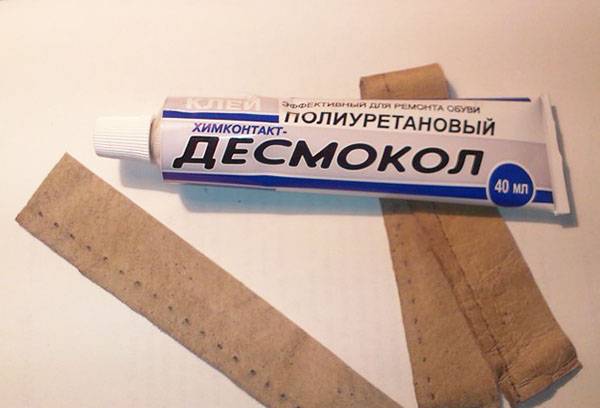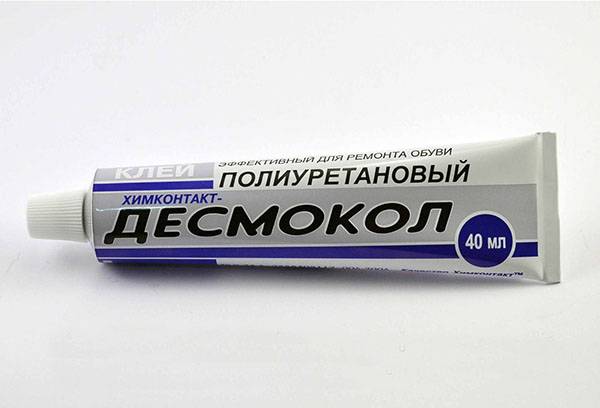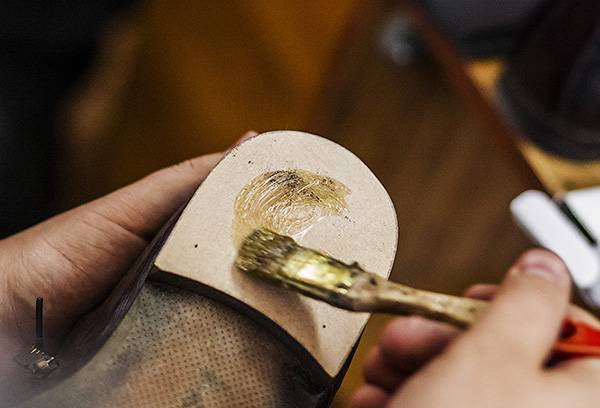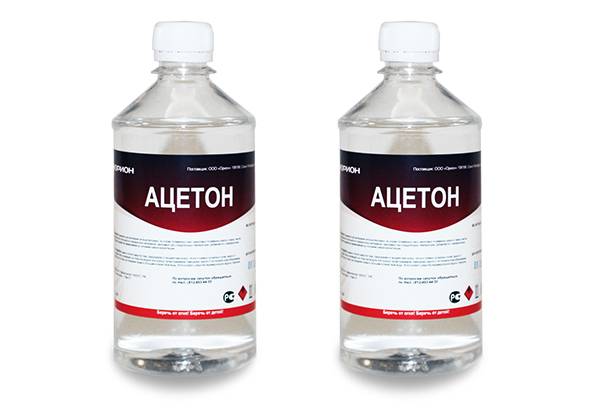Features of Desmokol glue and rules for its use
Content:
Polyurethane adhesive appeared on the Russian market quite recently, but due to its excellent technical characteristics it quickly became one of the most popular adhesives suitable for joining surfaces of various types. Using Desmokol glue, it’s easy to fix a chair by attaching a broken leg, stick linoleum behind the floor, or repair shoes that have torn off the sole.
Using this universal adhesive, you can combine a variety of materials: fabric, plastic, leather, metal and even glass. In any use, a high level of mounting reliability and an excellent result are guaranteed.
The composition and characteristics of the adhesive
Desmokol glue contains polyurethane resins, an organic solvent and various modifying components. This tool is widely used in the repair and production of shoes. Due to the ability to reliably connect surfaces of various types, glue is used to glue the upper part made of leather or fabric to the sole of polyurethane, PVC, rubber or thermoplastic. When casting soles from PVC, Desmokol glue is also added, which significantly increases the strength of the materials.
The adhesive composition has many advantages compared to other similar substances.
- The glue is completely transparent, therefore, after the repair, the junction is imperceptible, which allows you to completely restore the original appearance of shoes or other products.
- Polyurethane adhesive is not afraid of water. With this tool you can glue surfaces whose moisture content reaches 25%. Desmokol glue is often used to repair rubber boats, equipment for hunting and fishing.
- Universal adhesive does not collapse in the cold and does not crack under the influence of weights.
- It is convenient to work with glue, since it takes some time to dry completely, which means that it is possible to adjust the bonding place if necessary.
- Durability and reliability of the connection. Two materials glued together by Desmokol make up a single whole.
- The seam is obtained not only durable, but also elastic, without excessive rigidity.
On sale glue can be found in different packaging and conditions. For home repairs, the most convenient are small 50 ml tubes or 1 liter cans. On an industrial scale, barrels of 20 or 200 liters are used.
There is glue in the form of granules that you need to dilute yourself with a solvent. The cleaner the solvent, the higher the quality of the adhesive.
Storage and Precautions
Adhesive Desmokol will preserve its unique properties and characteristics only if properly stored. The main condition for the preservation of the product is the tightness of the package and maintaining the temperature in the range from +10 to + 25 ° С. In such conditions, the mixture will not lose its qualities within 1 year.
Important!
Desmocol contains a solvent, a rapidly flammable substance. Do not work with glue near an open flame, in addition, the room should have a good ventilation system.
Instructions for use "Desmokola"
Apply polyurethane adhesive to the surface and glue the parts in three ways.
- The usual way. The glued surfaces are cleaned and degreased, after which a thin layer of glue is applied to them. After 10 minutes, the procedure is repeated two more times and presses the surfaces against each other.
- With heating.The cleaned surfaces are lubricated with an adhesive and after 10 minutes they are heated with a hairdryer to 80 ° C.
- Wet way. Surfaces are thoroughly cleaned and moistened with water. Glue is applied in a thin layer, the parts are compressed and placed under a press. The resulting clutch will be the most dense and reliable.
What rules must be observed when working with Desmokol glue and how to pre-treat the glued surfaces, the author of purityis.decorexpro.com/en/ understood.
To achieve a reliable connection of surfaces, allowing you to provide your beloved shoes a second life, you can only thoroughly clean the parts from dust and dirt, old glue, pieces of material. After cleaning, the surface is treated with sandpaper and degreased.
When the preparatory work is over, glue is applied to the parts with a layer of 2-3 mm and the composition is allowed to dry for 7-10 minutes. If the material being processed is too porous and the glue has completely absorbed, you can apply an additional layer and wait a bit again. As a result, the adhesive layer should dry out and not stick to the fingers.
Glue "Desmokol" for shoes will provide the best connection if it is heated to a temperature of 80 ° C. For these purposes, you can use an industrial or home hair dryer, as well as other heating devices. Heated surfaces are pressed together as tightly as possible. Usually high-quality glue does not require the establishment of additional weights or clamps, but some masters use some kind of cargo to secure it.
Shoes can be worn one day after the repair.
Tip
To glue the parts of shoes that are constantly exposed to moisture or temperature changes, you can add the Desmodur additive to the glue in a ratio of 1: 7. This will provide thermal resistance and bond strength.
How to dilute granulated Desmokol
To dilute the glue, which is in a granular state, it is necessary to prepare pure acetone in a ratio of 1: 10, that is, for 20 g of glue - 200 ml of solvent. Pour granules with acetone and hold for 8 hours. The result is a heterogeneous transparent mixture, which must be mixed until smooth. In the instructions, the manufacturer notes that the process of dissolving the granules will take place faster in a warm room with an air temperature of +25 to + 30 ° C.



